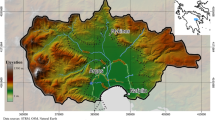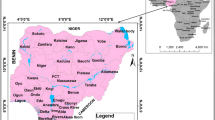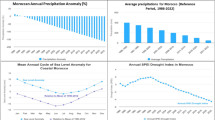Abstract
At present, demographic growth is a significant issue related to environmental damage due to an excessive use of water and forest. Governments are now interested in formulating new strategies that might help to reach a sustainable development. Thus, the Mexican Federal Government initiated an Environmental Hydrological Services Payment Programme in 2003 to preserve its forest territory, specifically to keep its groundwater recharge potential. However, the application of this programme was not supported by hydrogeological studies defining the physical media, rainwater and groundwater flows through proper identification of recharge areas as well as probable impacts to groundwater or to other components of the environment. Wide-view system studies still need to be incorporated. This work highlights the importance of including groundwater flow system investigations as a basis to support environmental projects where a clear understanding of groundwater functioning in relation to a zone receiving payment for hydrological environmental services is required. Stable isotopes and chemical characteristics of non-evaporated groundwater in discharge areas allow the computation of the altitude of recharging precipitation from where possible recharge area location is proposed. Finally, this paper puts forward groundwater flow system definition as a basic tool to support recommendation for an adequate water and environmental management.








Similar content being viewed by others
References
APHA, AWWA, WPCF (1992) Standard methods for the examination of water and wastewater, 18th ed. Washington, DC, USA
AQUACHEM (1977) Aqueous geochemical data analysis and plotting version 3.7. Software by Waterloo Hydrologic Inc., Waterloo
Cardona BA (1990) Caracterización fisico-química y origen de los sólidos disueltos en el agua subterránea en el valle de San Luis Potosí: su relación con el sistema de flujo. (Physicochemical characterization and dissolved solids origin in groundwater of the San Luis Potosi Valley: its relation with the flow system). M. Sc. Thesis, Facultad de Ingeniería Civil, Universidad A. de N.L., Méx
Cardona BA, Carrillo-Rivera JJ, Armienta MA (1993) Contaminación y valores de fondo en aguas subterráneas de San Luis Potosí. (Pollution and natural baseline of the San Luis Potosi groundwater). Geofísica Internacional 32–2:277–286
Cardona A, Rangel-García A, Carrillo-Rivera JJ (2004) Wastewater contamination affecting local flow systems: implications on intermédiate and regional systems used for water supply, San Luis Potosi, Mexico. Memories of the XXXIII IAH Congress and 7th ALHSUD, Zacatecas, México
Carrillo-Rivera JJ, Clark DI, Fritz P (1992) Investigating recharge of shallow and paleo-groundwaters in the Villa de Reyes basin, SLP, México, with environmental isotopes. Appl Hydrogeol 1–4:35–48
Carrillo-Rivera JJ, Ángeles-Serrano G, Hergt T (2003) Marco hidrogeológico conceptual a considerar en políticas de manejo de un área de descarga, caso: San Gregorio-Xochimilco. (Hydrogeological conceptual framework to be considered in management policy of a discharge area. Case: San Gregorio-Xochimilco). 2º Taller México-Cuba sobre Las ciudades, el recurso agua, y el manejo de cuencas hidrológicas. La Habana, Cuba
Carrillo-Rivera JJ, Perevochtchikova M, Táutiva M, Godoy A, Peñuela L, Hergt T (2004) Definición de indicadores de impacto al recurso hídrico en zonas receptoras de pago por servicios ambientales hidrológicos 2003–2004. (Definition of impact indicators to water sources in areas receiving payment for Environmental Hydrological Services 2003–2004). Convenio Instituto Nacional de Ecología-Instituto de Geografía UNAM. Informe final
Carrillo-Rivera JJ, Cardona A, Huizar-Alvarez R, Graniel E (2008) Response of the interaction between groundwater and other components of the environment in Mexico. Environ Geol 2:303–319
Clark I, Fritz P (1997) Environmental Isotopes in Hydrogeology. Chapter 3 Precipitation. Lewis Publishers, Boca Raton
Comisión Nacional del Agua-CONAGUA (2010) Estadísticas del agua en México. Edición 2010. (Statistics on Water on Mexico, 2010 edition). México
Constanza R, Jørgensen SE (2002) Understanding and solving environmental problems in the 21st century: toward a new, integrated hard problem science. Elsevier Science Ltd, Oxford
Cortés A, Durazo J (2001) Tendencia del oxígeno-18 en la precipitación del centro de México. (Oxygen-18 trend in precipitation in Central Mexico). Ingeniería Hidráulica en México XVI, núm. 2:93–102
Cortés A, Farvolden RN (1989) Isotope studies of precipitation and groundwater in the Sierra de las Cruces. Mexico J Hydrol 107:147–153
Cortés A, Arizabalo RD, Rocha R (1989) Estudio hidrogeoquímico isotópico de manantiales de la Cuenca de México (Hydrogeochemical isotopic study of springs in the Mexico Basin). Geofísica Internacional 28(2):265–282
Durazo J (2007) Modern isotopic precipitation in central Mexico and its hydrological manifestations in the Valley of Toluca. Internal Report, Instituto de Geofísica, UNAM
Edmunds WM, Carrillo-Rivera JJ, Cardona A (2002) Geochemical evolution of groundwater beneath Mexico city. J Hydrol 258:1–24
ESRI (2007) ArcGIS 9.2. http://www.esri.com
Fournier Origgi LA (1985) Recursos Naturales. (Natural resources). Editorial Universidad Estatal a Distancia. 6ª reimpresión de la 2ª edición. San José, Costa Rica. EUNED 2003
Giggenbach W (1988) Geothermal solute equilibria. Derivation of Na–K–Mg–Ca geoindicators. Geochim Cosmochim Acta 52:2749–2765
González-Morán T (1992) Estudio hidrogeofísico de la subcuenca de Chalco; evaluación de impacto ambiental del basurero de Santa Catarina. (Hydrogeophysical study in the Chalco sub-basin; environmental impact assessment for the Santa Catarina dumping site). Doctorate thesis in Geophysics (Groundwater).Unidad de los Ciclos Profesional y de Posgrado, Colegio de Ciencias y Humanidades. UNAM. México
Holtz U (2003) La Convención de las Naciones Unidas de Lucha contra la Desertificación (CNULD) y su dimensión política. [United Nations Convention to Combat Desertification (UNCCD) and its political dimension]. Bonn, may, 2003. http://www.unccd.int/parliament/data/bginfo/PDUNCCD(spa).pdf. Accessed 24 June 2009
Huizar-Alvarez R, Carrillo-Rivera JJ, Ángeles-Serrano G, Hergt T, Cardona A (2004) Chemical response to groundwater extraction southeast of Mexico City. Hydrogeol J 12:436–450
Instituto Mexicano de Tecnología del Agua-IMTA (2009) Conocimiento y tecnología para la gestión sustentable del agua. (Knowledge and technology for a sustainable water management). Informe anual IMTA 2009
Instituto Nacional de Estadística, Geografía e Informática-INEGI (2001) Síntesis de información geográfica del Estado de México. (Sumary of Geographical Information of the State of Mexico). México
Ortega AG, Farvolden RN (1989) Computer analysis of regional groundwater flow and boundary conditions in the Basin of Mexico. J Hydrol 110:271–294
Pantoja J (1993) Brief review of the geology of the trans-Mexican volcanic belt and the catchment of Mexico. Third International Conference on Rudists, Mexico DF. Guidebook of field trip B, pp 47–55
Peñuela-Arévalo LA (2007) Proceso de recarga-descarga de agua subterránea en zonas receptoras de pago por servicio ambiental hidrológico, Sierras Nevada y Las Cruces—México. (Process of groundwater recharge-discharge in areas receiving payment for Environmental hydrological services, Nevada and Las Cruces ranges-Mexico). M Sc thesis in Earth Sciences, Instituto de Geofísica. Universidad Nacional Autónoma de México UNAM. México, DF
Pérez-Cruz G (1988) Estudio sismológico de reflexión del subsuelo de la Ciudad de México. (Seismic reflection study of the Mexico City subsoil). M in Eng Thesis. DEPFI, UNAM
Radtke DB, Wilde FD, Davis JV, Popowski TJ (2006) Alcalinity and acid neutralizing capacity. In: US Geological Survey Techniques of water-resources investigations. Book 9, chapt 6, sec 6.6, vers 3, Jul 2007
Schoijet M (2005) Desertificación y tormentas de arena. (Desertification and sandstorms). Región y Sociedad XVII 32:167–187
Secretaría de Hacienda y Crédito Público-SHCP (1969) El hundimiento de la Ciudad de México. (Subsidence in Mexico City. Texcoco Project). Proyecto Texcoco. Volumen Nabor Carrillo. Secretaría de Hacienda y Crédito Público. México
Secretaria de Medio Ambiente y Recursos Naturales-SEMARNAT (2000) Inventario Forestal Nacional 2000. (National Forest Inventory 2000). México. 2001
Secretaria de Medio Ambiente y Recursos Naturales-SEMARNAT (2002) Norma Oficial Mexicana NOM-011-CNA-2000. Conservación del Recurso Agua. Que Establece las Especificaciones y el Método para Determinar la Disponibilidad Media anual de las Aguas Nacionales. (Mexican Official Norm NOM-011-CNA-2000. Conservation of water sources which establishes the specifications and methodology for computing mean annual availability of the Nation’s waters). Diario Oficial, México
Secretaría del Medio Ambiente (2007) Agenda Ambiental de la Ciudad de México. Programa de Medio Ambiente, 2007–2012. (Environmental Agenda for Mexico City. Environmental Program, 2007–2012). Secretaría del Medio Ambiente del Gobierno del Distrito Federal. México
Siebe C, Arana-Salinas L, Abrams M (2005) Geology and radiocarbon ages of Tláloc, Tlacotenco, Cuauhtzin, Hijo del Cuauhtzin, Teuhtli, and Ocusacayo monogenetic volcanoes in the central part of the Sierra Chichinautzin, México. J Volcanol Geoth Res 141:225–243
Tapia-Varela G, López-Blanco J (2002) Mapeo geomorfológico analítico de la porción central de la Cuenca de México: unidades morfogenéticas a escala 1:100,000. (Analytical geomorphologic mapping for the central portion of the Mexico Catchment: morphogenetic units at scale 1:100,000). Revista Mexicana de Ciencias Geológicas 19(1):50–65
Tóth J (1999) Groundwater as a geologic agent: an overview of the causes, processes, and manifestations. Hydrogeol J 7(1):1–14
University of Waterloo (1983) Notes of field methods in contaminant hydrogeology. Short Course Groundwater Research Institute, Dept. of Earth Sciences, Waterloo, pp 1–68
Vázquez-Sánchez E (1995) Modelo conceptual hidrológico y características hidráulicas del acuífero en explotación en la parte meridional de la Cuenca de México. (Conceptual Hydrological Model and Hydraulic Characteristics for the exploited aquifer in southern part of the Mexico Catchment). Master thesis. Instituto de geofísica, UNAM. México DF
Vázquez-Sánchez E, Jaimes-Palomera R (1989) Geología de la Cuenca de México (Geology of the Mexico Basin). Geofísica Internacional 28(2):133–190
Acknowledgments
The authors gratefully acknowledge all of the support provided by the institutes of Geophysics and Geography of the Universidad Nacional Autónoma de Mexico (UNAM), which was invaluable in each activity related to the present study.
Author information
Authors and Affiliations
Corresponding author
Rights and permissions
About this article
Cite this article
Peñuela-Arévalo, L.A., Carrillo-Rivera, J.J. Discharge areas as a useful tool for understanding recharge areas, study case: Mexico Catchment. Environ Earth Sci 68, 999–1013 (2013). https://doi.org/10.1007/s12665-012-1803-z
Received:
Accepted:
Published:
Issue Date:
DOI: https://doi.org/10.1007/s12665-012-1803-z




